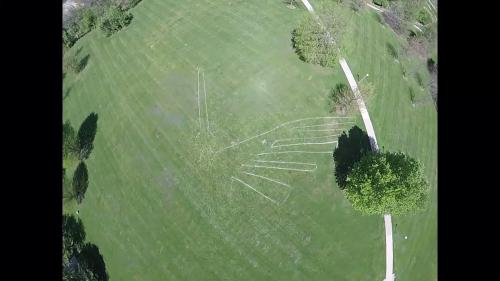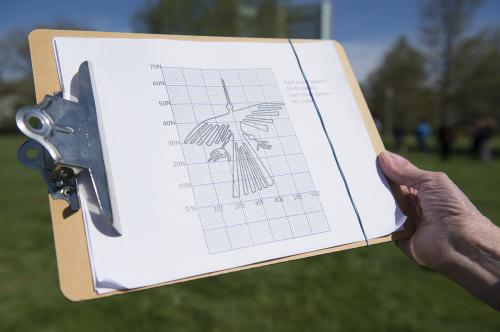WIU Anthropology Students to Create Geoglyph on Campus April 14
April 4, 2018

For the second year, WIU anthropology students will create a geoglyph near Currens Hall as part of their course work.
[Download Print-Quality Image]
MACOMB, IL – On Saturday, April 14, Western Illinois University anthropology students of Associate Professor Patricia Anderson will create a geoglyph on campus. This is the second year the course has been offered.
The experimental archaeological project will be created as part of Anderson's class, "Fantastic Archaeology: Ancient Astronauts, Shape Shifters and Bigfoot." The creation of the geoglyph is the culmination of a semester of studies about topics of "fantastic archaeology," including the famed geoglyphs of the Nazca Plains of Peru, attributed to the Nazca Culture (from 1,500-2,000 years ago).
The geoglyph will be placed on the field between Currens and Thompson halls, on the northwest side of the Macomb campus. Last year's class created a Nazca Condor on the same field.
As part of their classroom work, students select the geoglyph, then it is printed on graph paper as a reference. In the field, the outline of the geoglyph is made by plotting points on the ground and then connecting the points with cords. Once the outline is plotted, students run chalk markers along the edge of the cords to create a negative image of the design in white lime that will be visible from the air. Chad Sperry, director of the WIU GIS Center, will fly a drone over the image to photograph it from an aerial perspective.
Anderson said "fringe archaeologists" alternatively, in a racist and ethnocentric manner, discredit the Nazca people and claim the geoglyphs are the work of extraterrestrials. Her Anthropology 215 class is helping students examine alternate interpretations of the human past as a way to explore the nature of knowledge, develop critical thinking skills and to learn how anthropological and archaeological theory and methods can be used to distinguish between science and pseudoscience.
Students in the class have spent the semester learning about what questions to ask in assessing fringe or biased alternate interpretations of the human past in order to differentiate between scientific-based explanations and those lacking a scientific basis. In one of the course assignments, students will be asked to consider if it would be possible for the Nazca Lines to have been made by the Nazca people, based on the technologies that were available to them at the time. This exercise will encourage students to think, plan and work together as a team to execute the geoglyph on the WIU campus.
ANTH 215 is available for general education credit (three semester hours in social science) and is offered annually from the WIU Department of Sociology and Anthropology, on the Macomb campus. For more information on the course, contact Anderson at PK-Anderson@wiu.edu.
Posted By: University Communications (U-Communications@wiu.edu)
Office of University Communications & Marketing


Connect with us: